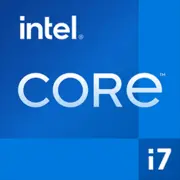Intel Core i7-13700K

インテル Core i7-13700K: 2025年プロセッサー完全レビュー
2025年3月
主な特徴: アーキテクチャとパフォーマンス
ハイブリッドアーキテクチャ Raptor Lake
2022年末に発売されたインテル Core i7-13700Kは、Raptor Lakeのハイブリッドアーキテクチャにより、2025年でも依然として存在感を示しています。これは、8つのパフォーマンスコア(P-コア)と8つのエネルギー効率の高いコア(E-コア)を組み合わせており、合計で16コアと24スレッドを提供します。これにより、タスクを効率的に分配することが可能で、P-コアは重いアプリケーションやゲームを担当し、E-コアはバックグラウンドプロセスをオフロードします。
インテル 7プロセス(10nm Enhanced SuperFin)は、エネルギー効率と高いクロック周波数のバランスを提供します。基本周波数は3.4GHz、最大ターボモードで5.4GHzまで達します。
パフォーマンスとキャッシュ
- L3キャッシュ 30MBは、ゲームやプロフェッショナルなタスクのデータ処理を加速します。
- Geekbench 6: 2829(シングルコア)/ 17484(マルチコア)。比較のために、Ryzen 7 7800X3Dは約2700/16500であり、i7-13700Kはマルチスレッドのシナリオでのリーダーです。
- 統合グラフィックス UHD 770はオフィスタスクやディスクリートGPUの故障時のバックアップには適していますが、ゲームにはやや頼りない — CS2の低設定で約30 FPSを出します。
主な特徴:
- 次世代SSDやGPU向けPCIe 5.0のサポート。
- コアの負荷を最適化するインテルスレッドディレクター技術。
- オーバークロックの可能性(「K」インデックス)。
互換性のあるマザーボード: ソケットとチップセット
LGA 1700: プラットフォームの最後の弦
i7-13700KはLGA 1700ソケットを使用しており、600シリーズと700シリーズのチップセットと互換性があります:
- Z790 — エンスージアスト向けの最上級選択肢: アンロックされた倍率、DDR5-5600のサポート、最大5 PCIe 4.0/5.0ライン。例: ASUS ROG Strix Z790-E(約300ドル)。
- B760 — 大多数向けの最適オプション: 限定的なオーバークロックでDDR4-3200との安定した動作。MSI B760 Tomahawk(約180ドル)のようなボードは、バジェット構成に人気があります。
- H770 — オフィスPC向け: オーバークロックなし、ポート数も最小限。
重要: 一部の600シリーズボード(例えばZ690)は、Raptor Lakeと互換性を持たせるためにBIOSの更新が必要です。2025年にはそういったモデルはほとんど存在せず、700シリーズを選ぶ方が簡単です。
メモリ: DDR4 vs DDR5
ハイブリッドサポート
i7-13700KはDDR4-3200とDDR5-5600の両方で動作します。2025年までにDDR5の価格は約100ドル(32GB 6000MHz)に下がりましたが、DDR4(約60ドル)も依然として需要があります:
- DDR5 — 将来への選択: 高い帯域幅はレンダリングやビデオ圧縮に不可欠です。
- DDR4 — ゲームで大きな損失なしにコスト削減: DDR4とDDR5のFPSの違いは5-8%を超えることはあまりありません。
アドバイス: DDR5を選ぶ場合は、自動オーバークロックのためにXMP 3.0をサポートするボードを探してください。
電源ユニット: どのくらいのワット数が必要?
力量の計算
TDP 125Wで、オーバークロック時の消費電力は最大250Wになる可能性があるため、最低限の電源ユニットの出力は650Wです。ただし、グラフィックスカード(例えばRTX 4070 Ti)を考慮すると、750-850Wを選ぶ方が良いでしょう。
推奨:
- Corsair RM750x(80 Plus Gold, 120ドル) — 静かで信頼性が高い。
- Be Quiet! Pure Power 12 M 850W(140ドル) — 組み立ての便宜のためのモジュラー設計。
安価なノンネームの電源ユニットは避けてください — 電圧の変動がプロセッサーにダメージを与える可能性があります。
i7-13700Kの長所と短所
強み:
1. 高いマルチスレッドパフォーマンス: BlenderでのレンダリングはRyzen 7 7700Xより30%速い。
2. DDR4のサポート: バジェット構成でのRAMコスト削減。
3. PCIe 5.0: NVMeストレージの将来への準備。
弱み:
1. 高温: 良質なクーラー(例えばNoctua NH-D15またはArctic Liquid Freezer II 360)がないと、負荷時に温度が95°Cに達する。
2. エネルギー消費: Ryzenよりも運用コストが高い。
3. Wi-Fi 7のサポートはほとんどのボードでなく、別途モジュールが必要。
使用シナリオ
ゲーム
2025年においても、i7-13700KはRTX 4080と組み合わせることで、4Kのウルトラ設定でAAAタイトルを快適にプレイできます。Cyberpunk 2077のレイトレーシングでは、安定して60FPSを維持します。
ワークタスク
- ビデオ編集: Premiere Proでの4Kビデオのレンダリングが12分(i5-13600Kの18分に対して)。
- 3Dモデリング: SolidWorksでは複雑なシーンでもプロセッサーが落ち込むことはありません。
マルチメディアとストリーミング
ストリーマーのMaximHardwareのようなエンスージアストは、24スレッドのおかげでOBSでのスムーズなストリーミングをFPSの損失なしに実現しています。
競合他社との比較
AMD Ryzen 7 7800X3D
- 長所: 3D V-Cacheによってゲームにおいて優れたパフォーマンス(+10% FPS)。
- 短所: マルチスレッドタスクで遅く(レンダリングが20%遅い)。価格は約400ドル。
インテル Core i9-13900K
- 長所: 24コア、プロフェッショナルタスクでのパフォーマンスが優れている。
- 短所: 価格が約550ドルで、発熱が大きい。
結論: i7-13700K(2025年には約350ドル)は、価格とパフォーマンスのバランスが取れた製品です。
ビルドのヒント
1. 冷却: 必ず水冷または強力なタワークーラーを使用。
2. マザーボード: オーバークロック用にはZ790の14フェーズVRM(例えば、Gigabyte AORUS Master)。
3. ケース: 優れた通気性(Lian Li Lancool IIIまたはFractal Design Meshify 2)。
結論: i7-13700Kは誰に適しているか?
このプロセッサーは次のようなユーザーに理想的です:
- ゲーマー: 4Kでゲームをプレイしながらストリーミングしたい人。
- プロフェッショナル: ビデオグラファーや3Dデザイナー。
- エンスージアスト: DDR4をそのままにアップグレードを計画している人。
2025年、i7-13700Kは次世代のパワーと手頃な価格の組み合わせを提供し、依然として魅力的な選択肢となっています。
基本
CPUの仕様
メモリ仕様
GPUの仕様
その他
ベンチマーク
他のCPUとの比較
関連する CPU の比較
ソーシャルメディアで共有する
または当サイトへのリンクを追加
<a href="https://cputronic.com/ja/cpu/intel-core-i7-13700k" target="_blank">Intel Core i7-13700K</a>

